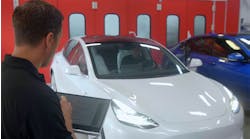Amongst the many oversimplifications of what defines the “essence” of “lean(er)” work systems, the one I gravitate toward most says something like this:
“Continually improve quality (correct work in less time) by learning to see, and then remove, waste (non-valueadding activities).”
The key is “learning to see.” Learning to see is a scientific pursuit, not trial and error. Seeing a problem requires a defined (standardized) outcome against which to measure the result of our activities. In order to make use of any observations about our value delivery process, it must run in a consistent manner (like a manufacturing assembly line), follow instructions that define correct work in process, have a defined beginning measurement point, internal measurement intervals (to see numerically “how it’s going”) and an end point when quality (a written, measureable standard) is finally met.
Conversely, you cannot raise much useful (clean) data by giving four technicians three jobs each, all at the same time, fraught with the same problems (supplements), watch them all bottleneck in paint, all struggle for attention from the production manager or estimator to get more stuff ordered, or wait for instructions, etc. Although the problems are painfully obvious, the cause—why the system as a whole, or HPCPD (hours per car per day)— is unclear.
Hypothetically, let’s say we want to measure cycle time of bumper repair jobs in hours. Bumper jobs (with no surprises behind) average eight labor hours (body, paint, etc.). It’s not uncommon for them to take three days. Let’s try to measure why.
The clock starts when we have the car and customer/insurer OK to start (approval of the parking lot estimate). The clock stops when the car is done, inspected, and meets our quality check standards. We expect this to be one or two days. It turns out to be three.
If we watched this repair from beginning to end, in real time (which is absolutely essential in order to learn anything meaningful), we would find lots and lots of starting and stopping as the people doing the work juggle a myriad of repair orders with varying complexities, in various stages of disarray (stopped). If we merely pop in and out of our office over three days, we are relegated to asking others “why” is this bumper sitting (no one touching it)? We would likely find ourselves explaining to techs that this work “should” only take a few hours as if that wasn’t already obvious to them as well. If we personally “managed” (expedited) that bumper by staying with the part, making sure it had hands on it continuously until finished, we would likely conclude two things:
1. We really know how to get work done efficiently—by standing over it and the people adding the value, and by issuing tactical commands, pulling levers and strings, to “make it happen” (from this evolved the production manager role).
2. We would also discover that other jobs went slower at the bumper job’s expense. Why?
A scientific study, predicated upon lots of direct, uninterrupted observation, would get closer to the root cause of “why” our process delivers such low HPCPD. In the absence of that correct approach, you generally find some hasty opinion about “people not focusing/trying” and the deployment of dogmatic policies, coupled with, of course, some monetary incentive or forceful order to “ just get the work done”.
We already know how this works. Since the “actual” obstacles causing techs to constantly start and stop haven’t been removed, and because they will have to quit if they can’t accrue enough “hours,” we are relegated to giving them multiple cars (three, four, five) at a time, from which to assemble some form of a check. Beyond two or three technicians, since we still have no idea what the root cause of the start/stop problem is (we think it’s motivational, people based), we deploy a traditional production manager. A unique job description. The keystone that keeps the whole bucket of balls in the air by:
1. Greasing the wheels through interpersonal ability to get techs to tolerate the mess they face every day (finish car to get check, in lieu of wrong parts, missed damage, bottlenecks, etc.).
2. Alleviating tension between estimators and techs (both commissioned on how much they can bill) and insurance appraisers, who had to be deployed to keep the former pursuit at bay.
3. Working late hours creating futile spreadsheets and work plans for the next day that unravel within the first three hours (because of the variability of circumstances—20 or more cars in process statistically yields literally thousands of different outcomes).
This person (in lieu of a logical system dictating what, where and when) also becomes the default decision maker for everything from color-match decisions to what to do when a supplement arises (as if the same problem and solution hasn’t happened 6,400 times in the past).
Incidentally, this role is obsolete. The role’s success depends upon finding a person that is good at everything (interpersonal negotiations, estimatics, profound knowledge of collision repair, Excel, master at negotiation, etc.) and wants to leverage all of those abilities in a thankless, high-stress position, where daily success is measured by keeping the wheels from coming off.
Conventional wisdom then says having a production manager sort of works, so maybe we just need a better one (bigger hammer). Scientific observation would quickly reveal that the lack of a functioning work system is at the core of this unmanageable variability. Ninety-nine percent of what the traditional production manager does (expediting) can be eliminated in very short order through the deployment of a standards-based work system of connected activities (from sale to repair plan to parts order to repair start, paint, assembly, cleanup, and delivery).
First, the most egregious abnormalities (supplements), which generate the most questions (and stops), go away. Second, visual management replaces all meetings, spreadsheets, work plans, etc., so the techs know just by looking at the wall, what to do next. Third, standardized work instructions make clear how far to take the work, and what measurable conditions must be met before passing that work ahead. Fourth, predefined quality standards and rules dictating what to do if they are not met (not the variability of asking the production manager, or estimator, whose opinion may vary by how close to the end of the month we are), make clear to those doing the work what to do when work is not right.
Now, this sensible, less-waste way of working is cruise control, not auto pilot. It is stable regardless of who works within (not true of traditional models where the “manager” and their presence are key to work moving). The production manager role is now liberated to evolve into real, meaningful work, where actions are few, thoughtful, and take longer to arrive at, but, have longterm consequences (lasting improvement vs. shortterm Band-Aids to expedite work). This role becomes that of a scientist, observing, experimenting, and improving the system continuously. The value of the position both to the system and the person filling the role accelerate (win-win).
Aaron Marshall manages Marshall Auto Body in Waukesha, Wis. He can be reached at [email protected].




